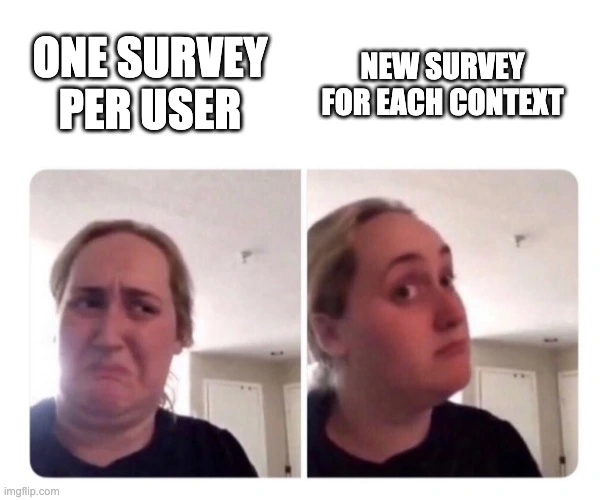From One Survey Per User to One Survey Per Context: How We Learned to Think Bigger
When we first built Pheedback, we thought we had solved the feedback problem. Our micro-surveys embedded directly into products, asked contextual questions at the right moment, and delivered much higher response rates than traditional surveys.
But we had a blind spot.
Our approach was “one survey experience per user.” Once someone answered our questions, they wouldn’t see them again. This seemed logical: why bother users with the same questions twice?
Then our customers started showing us scenarios we hadn’t considered.
The Support Ticket That Changed Everything
A customer success team was using Pheedback to gather feedback about their support quality. They embedded our survey widget on their support ticket pages, asking “How satisfied were you with the resolution of this ticket?”
The system worked beautifully until they realized a fundamental flaw.
A customer had submitted two support tickets in the same week. The first ticket was resolved quickly and expertly. The second ticket took three days and multiple back-and-forth exchanges before reaching a mediocre resolution.
But here’s what happened: The customer saw our feedback survey after the first ticket and rated the experience highly. When they viewed the second ticket, no survey appeared. The poor experience with the second ticket went completely unmeasured because our system thought, “We already got feedback from this customer.”
The customer success team was missing half the story.
The Aha Moment: Context Matters More Than Users
This scenario repeated across different use cases:
- E-commerce teams wanted feedback on individual product pages, not just one overall shopping experience
- SaaS companies needed insights about specific features, not generic app satisfaction
- Service businesses required feedback for each client interaction, not just the first one
We realized our fundamental assumption was wrong. Users don’t have “an experience” with your product—they have multiple, distinct experiences that deserve individual feedback.
A user might love your checkout process but hate your search functionality. They might rate one support interaction as excellent and another as poor. They might find Feature A intuitive and Feature B confusing.
By limiting ourselves to one survey per user, we were forcing businesses to settle for incomplete insights.
Rethinking Our Architecture
The solution required more than a simple feature addition. It demanded rethinking how we approached feedback collection entirely.
We introduced what we call “context-aware feedback”: the ability for each distinct experience within your product to trigger its own feedback cycle.
Here’s how it works in practice:
Support Ticket Example
- First ticket: User sees feedback survey, rates experience highly
- Second ticket: User sees feedback survey again (new context), rates experience poorly
- Result: Business understands performance varies significantly by ticket
Product Page Example
- Product A page: “How helpful was this product information?” gets positive response
- Product B page: “How helpful was this product information?” gets negative response
- Result: Business discovers Product B needs better descriptions
Feature-Specific Example
- After using Search: “Did you find what you were looking for?” receives negative feedback
- After using Checkout: “How was the checkout process?” receives positive feedback
- Result: Business knows to improve search, not checkout
The Technical Challenge
Implementing context-aware feedback required solving several technical puzzles:
Context Identification: How do we know when a user is in a “new” context that deserves fresh feedback? We developed a context_id system that lets businesses define what constitutes a unique experience.
Survey State Management: How do we track which questions have been answered in which contexts without overwhelming users? We built intelligent frequency management that respects user attention while capturing necessary insights.
Data Organization: How do we organize feedback so businesses can understand both individual context performance and overall trends? We redesigned our analytics to support both granular and aggregate views.
What We Learned
Building context-aware feedback taught us several important lessons:
Users Are More Complex Than We Assumed
People don’t interact with products as monolithic experiences. They engage with specific features, pages, and workflows—each with its own success criteria.
Context Drives Quality
When feedback questions are tied to specific contexts, responses are more detailed and actionable. Asking “How was Feature X?” immediately after someone uses Feature X yields better insights than asking “How was your overall experience?” days later.
Businesses Need Granular Insights
Product teams don’t just want to know if users are happy overall. They need to understand which specific parts of their product are working and which aren’t.
One Size Doesn’t Fit All Experiences
The same user might have vastly different experiences with different parts of your product. Capturing this nuance is crucial for making targeted improvements.
Real-World Impact
The results of context-aware feedback have been significant for our customers:
-
A SaaS company discovered their onboarding flow had high satisfaction rates, but their reporting feature had much lower satisfaction. Without context-specific feedback, these experiences would have been averaged together, masking the reporting issues.
-
An e-commerce business found that customers loved their product pages but were frustrated with their search functionality. This insight helped them prioritize search improvements.
-
A support team identified that tickets handled by different agents had varying satisfaction rates. This data drove targeted training initiatives.
Implementation Considerations
If you’re thinking about implementing context-aware feedback, consider these factors:
Define Your Contexts Clearly
What constitutes a unique experience in your product? Support tickets, product pages, feature interactions, or user workflows? Be specific about what deserves its own feedback cycle.
Balance Frequency with User Experience
Just because you can ask for feedback in every context doesn’t mean you should. Implement smart frequency capping to avoid survey fatigue while capturing necessary insights.
Design for Actionability
Make sure your contexts align with how you organize your product development efforts. Feedback about specific features should go to the teams responsible for those features.
Plan Your Analysis Strategy
Context-aware feedback generates more granular data. Ensure you have the analytical capabilities to turn this detailed feedback into actionable insights.
Looking Forward
Context-aware feedback represents a fundamental shift from treating users as single data points to recognizing them as complex individuals with multiple, distinct experiences.
This approach doesn’t just improve data quality. It changes how businesses think about user experience entirely. Instead of optimizing for overall satisfaction, teams can focus on improving specific touchpoints that matter most to their users.
As we continue evolving Pheedback, we’re exploring even more sophisticated ways to understand user context. This includes behavioral triggers, emotional states, and external factors that influence experience quality.
But the core lesson remains: users are complex, their experiences are varied, and our feedback systems need to reflect that complexity to drive meaningful improvements.
The Bottom Line
We learned that thinking bigger about feedback doesn’t mean asking more questions. It means asking the right questions at the right moments in the right contexts.
When we stopped limiting ourselves to one survey per user and started thinking about one survey per meaningful experience, our customers began uncovering insights that had been hidden in plain sight.
Sometimes the biggest breakthroughs come from questioning our most basic assumptions. In our case, the assumption that users have “an experience” rather than “experiences” was limiting both our product and our customers’ insights.
Ready to implement context-aware feedback in your product? Get started with Pheedback and start capturing the full complexity of your user experiences.


